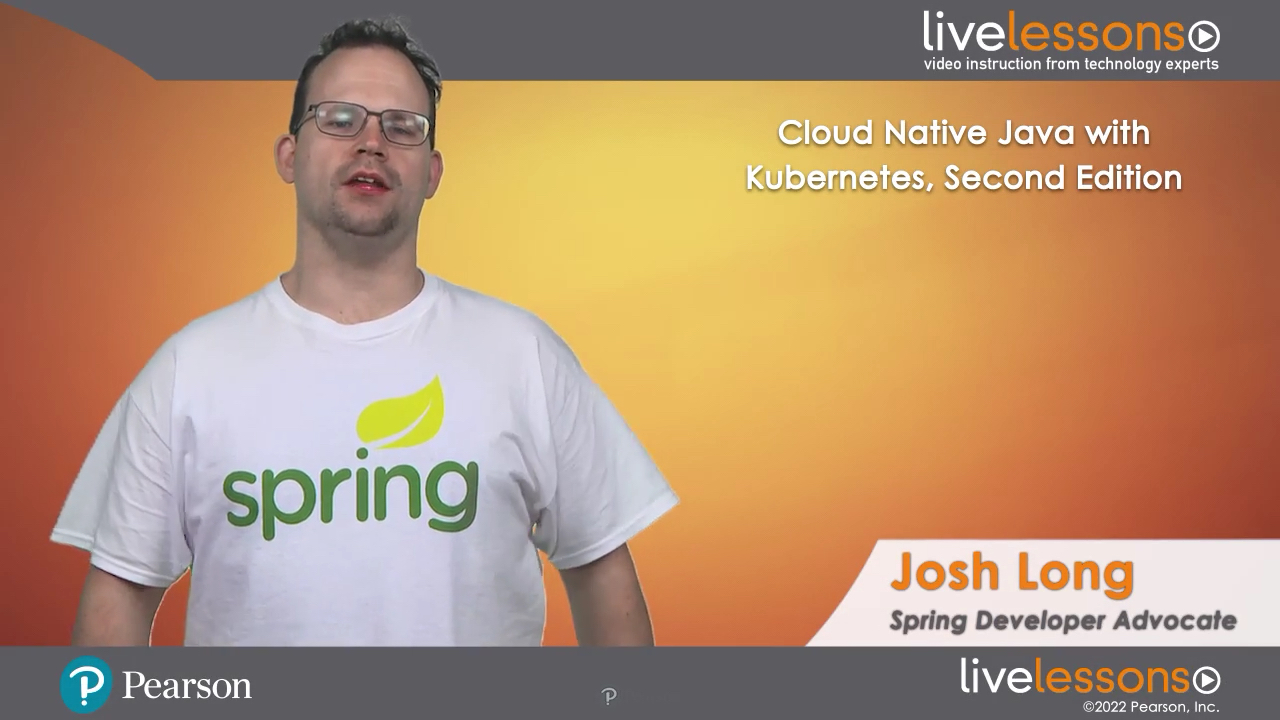Cloud Native Java with Kubernetes LiveLessons, 2nd Edition (Video Training), 2nd Edition
- By Josh Long
- Published Jan 11, 2022 by Addison-Wesley Professional.

Online Video
- Your Price: $279.99
- List Price: $349.99
- About this video
Video accessible from your Account page after purchase.
Register your product to gain access to bonus material or receive a coupon.
Description
- Copyright 2022
- Edition: 2nd
- Online Video
- ISBN-10: 0-13-783399-7
- ISBN-13: 978-0-13-783399-3
10.5+ Hours of Video Instruction
Description
Work takes time to flow through an organization and ultimately be deployed to production, where it captures value. It's critical to reduce time-to-production. Software is a competitive advantage for many organizations and industries.
Organizations break their larger software ambitions into smaller, independently deployable, feature-centric batches of work--microservices. To reduce the round trip between stations of work, organizations collapse or consolidate as much of them as possible and automate the rest; developers and operations beget "devops"; and cloud-based services and platforms (like Cloud Foundry) automate operations work and break down the need for ITIL tickets and change management boards.
But velocity, for velocity's sake, is dangerous. Microservices invite architectural complexity that few organizations are prepared to address.
In Cloud Native Java with Kubernetes LiveLessons, 2nd Edition, we look at how high-performance organizations are addressing the requirements of distribution with Spring Boot, Spring Cloud, and Kubernetes to be more resilient, reliable, robust, and scalable.
Related Titles
Microservices with Spring Boot LiveLessons, 2nd Edition by Josh Long and Philip Webb
Reactive Spring Boot LiveLessons, 2nd Edition by Josh Long
Skill Level
Intermediate
What You Will Learn
* How high-performance organizations are addressing the requirements of distribution with Spring Boot, Spring Cloud, and Kubernetes
* The need for cloud native
* Foundational first steps in Java, Kotlin, Spring Boot, Reactive Programming, Containers, and Kubernetes
* How to turn applications into docker images to package for production
* How to build native images with Spring Native
* Build observable services
* Implement continuous integration and continuous delivery
* Build applications into the production cloud with Azure Spring Cloud
* Build distributed systems including configuration, service registration, and discovery and RSocket and edge services
* Extend the platform by building on top of Kubernetes to enhance the platform using Spring
Who Should Take This Course
* Java developers interested in deploying applications to the cloud using Spring Cloud
* Enterprise developers who need to quickly build new applications that are scalable, portable, resilient, and easily updated
Course Requirements
Experience with Java EE or Spring and a basic knowledge of distributed computing, cloud-based services, Agile methods, and microservice architectures.
About Pearson Video Training
Pearson publishes expert-led video tutorials covering a wide selection of technology topics designed to teach you the skills you need to succeed. These professional and personal technology videos feature world-leading author instructors published by your trusted technology brands: Addison-Wesley, Cisco Press, Pearson IT Certification, Sams, and Que. Topics include IT Certification, Network Security, Cisco Technology, Programming, Web Development, Mobile Development, and more. Learn more about Pearson Video training at http://www.informit.com/video.
Sample Content
Table of Contents
Lesson 1: Motivating Cloud Native
Learning Objectives
1.1 Motivating Cloud Native
Lesson 2: Bootcamp
Learning Objectives
2.1 Introduction
2.2 First Steps with Java
2.3 First Steps with Kotlin
2.4 First Steps with Spring Boot--Part 1
2.5 First Steps with Spring Boot--Part 2
2.6 First Steps with Reactive
2.7 First Steps with Docker and Kubernetes
Lesson 3: Packaging for Production
Learning Objectives
3.1 Introduction
3.2 Building a Docker Image with a Dockerfile
3.3 Building a Docker Image with Buildpacks
3.4 Using the Google Jib Maven Plugin
3.5 Using the Spotify Maven Plugin
3.6 Using the Spring Boot Maven Plugin
3.7 Using the Spring Boot Maven Plugin and Spring Native GraalVM
3.8 Summary
Lesson 4: Spring Native
Learning Objectives
4.1 Introduction
4.2 Building a Basic Application with the Out of the Box Support
4.3 Looking at Various Hints - Part 1
4.4 Looking at Various Hints - Part 2
4.5 Packaging Your Own Hints
Lesson 5: Building Observable Services
Learning Objectives
5.1 Introduction
5.2 The Spring Boot Actuator
5.3 The Health Actuator and Kubernetes
5.4 Distributed Tracing with Spring Cloud Sleuth
5.5 The Spring Boot Admin
Lesson 6: That Continuous Thing
Learning Objectives
6.1 Introduction
6.2 Continuous Integration and Delivery with GitHub Actions
6.3 Continuous Delivery
Lesson 7: Azure Spring Cloud
Learning Objectives
7.1 Introduction
7.2 Up and Running with Azure Spring Cloud
Lesson 8: Configuration
Learning Objectives
8.1 Introduction
8.2 Basics of Environment, PropertySource, @ConfigurationProperties, and Environment Specific Configuration Sources
8.3 Binding
8.4 The Environment Abstraction
8.5 Refreshable Configuration (@RefreshScope)
8.6 Environment Specific Configuration
8.7 Getting Config with Spring Cloud Kubernetes
8.8 The Spring Cloud Config Server
8.9 The Spring Cloud Bus and Spring Cloud Config Monitor
Lesson 9: Service Registration and Discovery
Learning Objectives
9.1 Introduction
9.2 The Discovery Service
9.3 Client-side Load-balancing
9.4 Hedging
Lesson 10: RSocket
Learning Objectives
10.1 Basic Client/Services
10.2 Bidirection Client/Services
10.3 Spring Security
10.4 Next Steps
Lesson 11: Edge Services
Learning Objectives
11.1 Introduction to Existing Services
11.2 Spring Cloud Gateway
11.3 Reactive Service Orchestration and Composition
11.4 Eureka for Service Registration and Discovery and Client-Side Load-Balancing
11.5 Spring GraphQL for Data Gateways - Part 1
11.6 Spring GraphQL for Data Gateways - Part 2
Lesson 12: Programming the Platform
Learning Objectives
12.1 Introduction
12.2 Using the Kubernetes Java API
12.3 Turning the Application into a Native Binary with GraalVM and Spring Native
12.4 Deploying to Kubernetes
Summary
More Information
